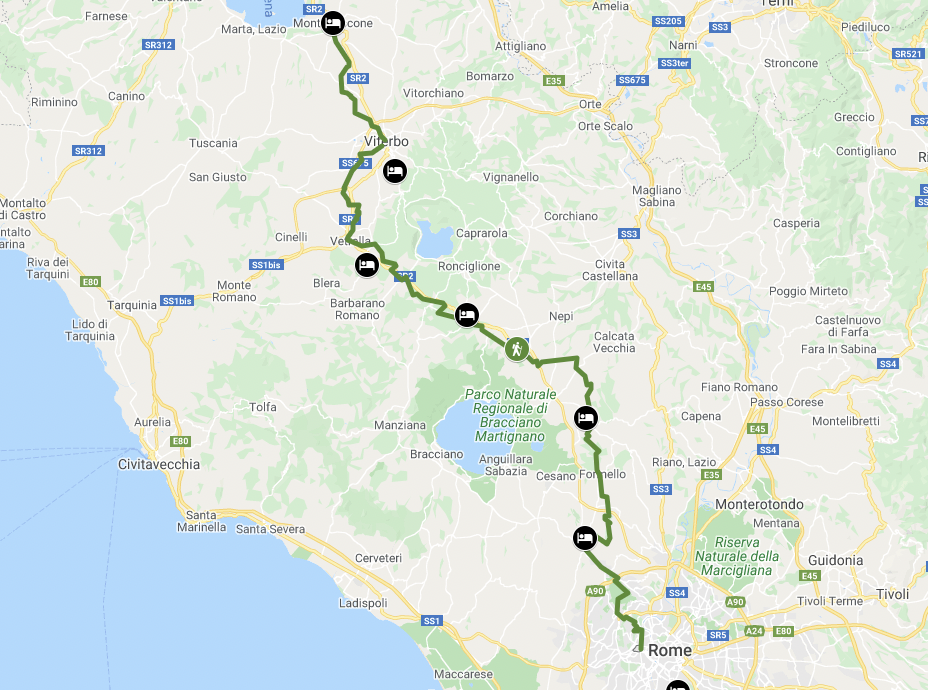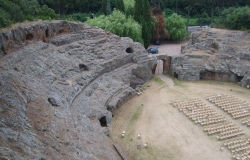At the beginning of the second millennium, a huge number of pilgrims began crossing through Europe in search of the lost “Celestial Land”, the “Patria Celeste”. The pilgrims travelled to three major destinations: Rome, the city of the martyrdom of Saints Peter and Paul (the founders of the Christian Church). The Holy Land, site of Calvary, where the pilgrims sought out the places of Christ’s Passion; Santiago de Compostela, the furthest point of Western Europe which the Holy Apostle James chose as his final resting place. The way to Rome, Via Francigena (or Via Romea) which led to the Eternal City from the Western Alps and the Rhineland, was used for 7 centuries by sovereigns, emperors, plebeians and clergymen and was probably the most important road of the times. The Via Francigena led all the way from Canterbury to Rome and was one of the pathways of European history. It was a main thoroughfare along which hundreds of thousands of pilgrims passed on their way to Rome. In those days, the journey was not just an adventure or a risk but an act of devotion in itself, and the pilgrims would stop off along the way at places deemed holy by the Church. Nowadays, we are able to reconstruct the itinerary thanks to a document left behind by Archbishop Sigeric of Canterbury, who, upon his return from Rome to his dioceses in 994, wrote down the names of the places that had formed the stages of his journey home. It is only natural that one thousand years later, on the eve of a new millennium, there should be a reawakening of interest in the old route and a desire to rediscover a road that once represented unity and communication between the different cultures and ideas of European nations which are once again opening their borders. The Via Francigena bears witness to how even then there was a desire for unity in Europe. The route cut through the Alps in the Valley of Aosta and proceeded southwards through Piedmont, Lombardy, the flatlands of the River Po (Padania), before going through the Apennines near Berceto to pass into Tuscany and Latium, and ends in Rome. This “way to Rome” is an essential and formative phenomenon in the history of Europe. Fragments and reminders of its existence are still to be found scattered throughout our area.
The Etrurian Section of the Via Francigena
Montefiascone sits atop a volcanic ridge overlooking the Bolsena caldera lake. It is a medieval papal town also known for its great white wine, “Est,Est,Est”. You continue through hazelnut forests and gently rolling hills, sometimes walking on sections of ancient roman road, till you arrive in Viterbo. This ancient town was the favorite residence of the Medieval Popes who built a palace next top the Duomo of San Lorenzo. Viterbo was an important rest stop along the Via Francigena for the Medieval pilgrims and is the last large town before making the final trek to Rome. After Viterbo the Via Francigena takes you through shady forests passing near the the Cistercian Abbey of St Martins in Cimino. Continuing on to Vetralla and little parish Church of Santa Maria in Forcassi, mentioned by Sigeric. You continue on to the town of Sutri famous for its ancient stone theatre carved into the rock. At Campagnano where you leave the ancient Via Cassia way for the Via Trionfale now a large road with heavy traffic entering the heart of the Eternal City – Rome, at last.
- Fascinating countryside: the Lake of Bolsena and tuff stone gorges
- Ancient Etruscan villages and historical sites: necropolis, the Fortress of the Popes
- Nature Reserves: Regional Park of the age-old city of Sutri and its Roman amphitheater
- Small, comfortable, family run accommodations with delicious culinary specialities
| SEASON | MARCH THRU OCTOBER |
| DURATION | 8 DAYS/7 NIGHTS |
| DEPARTURE | DAILY |
| STARTING POINT | MONTEFIASCONE |
| ENDING POINT | ROME |
| ITINERARY | VITERBO – VETRALLA – SUTRI – CAMPAGNANO – ISOLA FARNESE |
| LENGTH OF HIKING | 120 KM |
| DIFFICULTY | 🔴 🔴 🔴 ⚪️ |
| ACCOMMODATIONS. | SELECTED B&B, HOTELS (3-4 STARS), FARM HOLIDAY |
| CODE: SC-IITSM214 |
This itinerary is designed for individual travelers, therefore based with a minimum of 2 people traveling together. Extra departure dates can be always arranged with a minimum of 5 travelers.
Please use our contact form or request form to submit your requests or questions.

